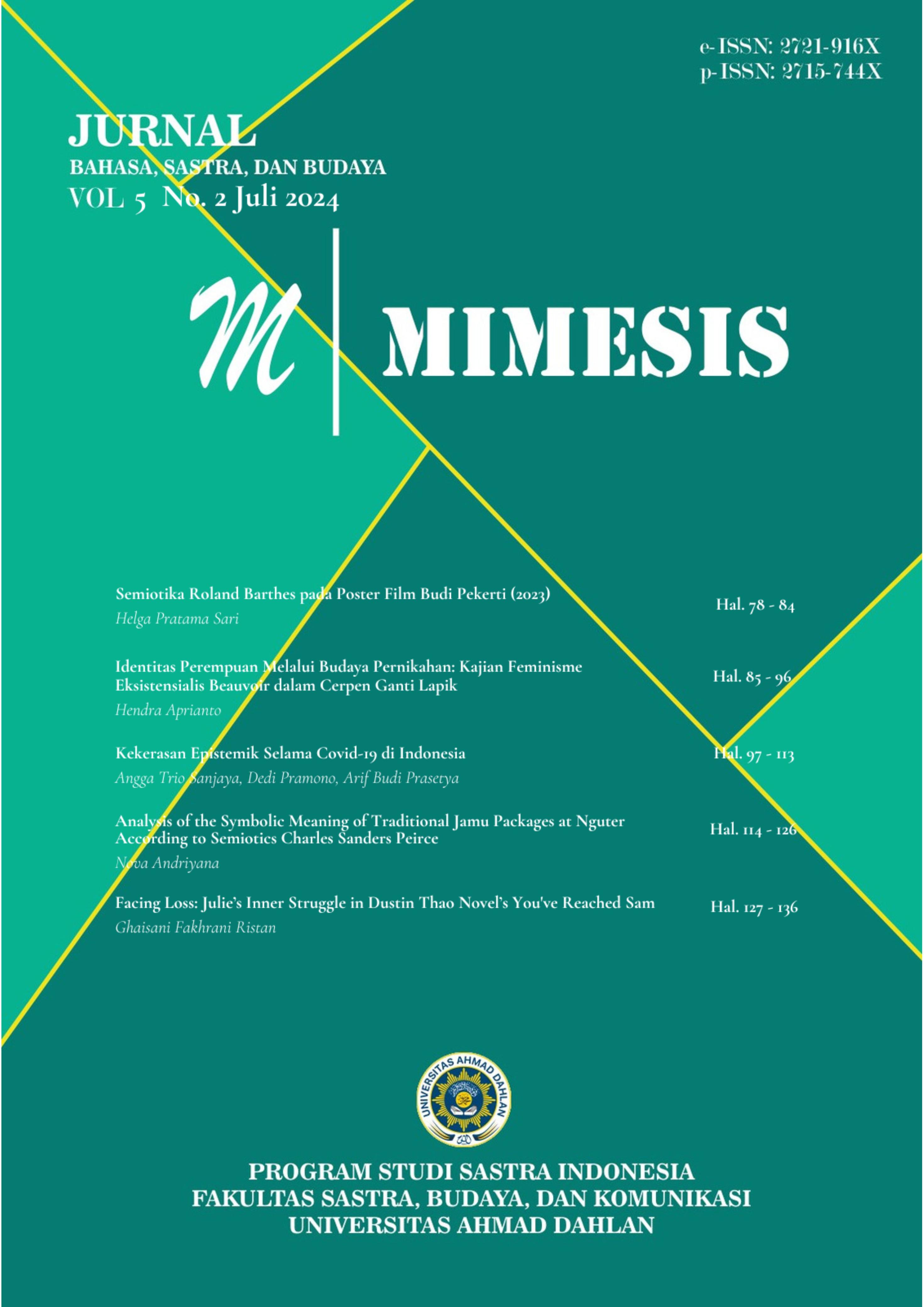Semiotika Roland Barthes pada Poster Film Budi Pekerti (2023)
DOI:
https://doi.org/10.12928/mms.v5i2.9582Keywords:
Budi Pekerti, Film poster, Roland Barthes, Semiotics, SignificationAbstract
Semiotics studies exist as a reading of the existence of signifier and signified which are currently called signs. Barthes in his method divides the significance of meaning into three stages, namely the denotation stage, the connotation stage, and the myth. These signs also can be found in film posters. The film poster that will be discussed in this research is Budi Pekerti (2023), directed and written by Wregas Bhanuteja. This research uses qualitative research methods. Qualitative methods aim to understand social phenomena seen from the participant’s perspective. The signifier and signified present in the Budi Pekerti film poster certainly produce connotation and denotation meanings that are in line with Barthes’s thinking.
References
Alpina, C., Rozi, F., & Desky, A. F. (2023). Representasi Pubertas pada Remaja Perempuan dalam Film Animasi “Turning Red” (Analisis Semiotika Roland Barthes). JISOS: Jurnal Ilmu Sosial, 1(12), 1175-1188.
Bagus, L. (2000). Kamus Filsafat. Jakarta: Gramedia Pustaka Utama.
Birowo, A. (2004). Metode Penelitian. Komunikasi. Yogyakarta: Gitanyali.Bungin, Burhan. (2015). Metodologi Penelitian Kualitatif. Jakarta: Rajawali Pers.
Hoed, B. (2014). Semiotik & Dinamika Sosial Budaya. Depok: Komunitas Bambu.
Piliang, Y. A. (2004). Semiotika Teks: Sebuah Pendekatan Analisis Teks. Mediator: Jurnal Komunikasi, 5(2), 189–198. https://doi.org/10.29313/mediator.v5i2.1156
Rohmaniah, A. (2021). Kajian Semiotika Roland Barthes. Al-Ittishol, 2(2), 124–134. Sugiyono. (2018). Metode Penelitian Kuantitatif Kualitatif. Dan R&D. Bandung: Alfabeta.
Suswandi, I. (2020). Gender dalam Pelabelan Nama Kuliner Nusantara: Suatu Tinjauan Semiotik Studi Kasus: Kuliner Di Kota Depok. Mimesis, 1(1), 1–10. http://journal2.uad.ac.id/index.php/mimesis/article/view/1539/pdf
Tamara, J. (2020). Kajian Semiotika Roland Barthes pada Poster Unicef. Journal of Education, Humaniora and Social Sciences (JEHSS), 3(2), 726–733.
Thomas, T. (1995). Meaning in Interaction: An Introduction to Pragmatics. London: Longman.
Downloads
Published
Issue
Section
License
Copyright (c) 2024 Helga Pratama Sari

This work is licensed under a Creative Commons Attribution-ShareAlike 4.0 International License.
License and Copyright Agreement
In submitting the manuscript to the journal, the authors certify that:
- They are authorized by their co-authors to enter into these arrangements.
- The work described has not been formally published before, except in the form of an abstract or as part of a published lecture, review, thesis, or overlay journal.
- That it is not under consideration for publication elsewhere,
- That its publication has been approved by all the author(s) and by the responsible authorities tacitly or explicitly of the institutes where the work has been carried out.
- They secure the right to reproduce any material that has already been published or copyrighted elsewhere.
- They agree to the following license and copyright agreement.
Copyright
Authors who publish with Mimesis agree to the following terms:
- Authors retain copyright and grant the journal right of first publication with the work simultaneously licensed under a Creative Commons Attribution License (CC BY-SA 4.0) that allows others to share the work with an acknowledgment of the work's authorship and initial publication in this journal.
- Authors are able to enter into separate, additional contractual arrangements for the non-exclusive distribution of the journal's published version of the work (e.g., post it to an institutional repository or publish it in a book), with an acknowledgment of its initial publication in this journal.
- Authors are permitted and encouraged to post their work online (e.g., in institutional repositories or on their website) prior to and during the submission process, as it can lead to productive exchanges, as well as earlier and greater citation of published work.











